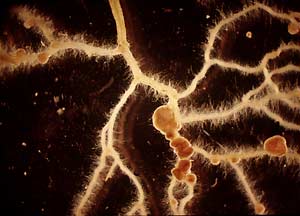UC Berkeley Press Release
 Yellow bush lupines like these overlooking Salmon Creek Beach at the Bodega Marine Reserve get nitrogen from bacteria infecting their roots in exchange for nutrients the bacteria cannot get on their own. The lupines don't tolerate freeloaders, however. They appear to select bacteria good at sharing nitrogen by limiting the size of nodules housing bacteria that don't share. (Photo by Ellen Simms/UC Berkeley) |
Plants, too, have ways to manage freeloaders
BERKELEY – Many, if not all, plants maintain relationships with bacteria, and like any hardworking homeowner, they have developed ways to get rid of freeloaders, University of California, Berkeley, biologists have found.
In a study of a coastal California lupine that harbors nitrogen-fixing bacteria in its roots, UC Berkeley researchers have shown that the roots respond differently to bacteria that efficiently produce nitrogen than they do to the slackers. Root nodules - in which bacteria share nitrogen with the plant in return for energy - grow bigger when infected with bacteria that are good at sharing nitrogen, but remain small when they house bacteria that are not.
 Nodules on lupine roots typically house only one strain of nitrogen-fixing bacteria, which makes it easier for the plant to favor the good nitrogen sharers and punish the slackers. |
The finding illustrates the complex symbiotic relationships that have evolved between organisms, ranging from one-sided parasitism to mutualism, a situation in which both parties benefit.
It also suggests that agricultural practices, including heavy use of nitrogen fertilizer, could disrupt these relationships and create plants with a reduced ability to choose among root bacteria.
"It's important to look at this from an evolutionary perspective and to think about plants making choices both before and after infection," said Ellen Simms, UC Berkeley professor of integrative biology and leader of the study. "We may have bred this ability out of our crops."
Simms and her colleagues, including D. Lee Taylor, a former UC Berkeley post-doctoral fellow now at the Institute of Arctic Biology in Fairbanks, Ala., current UC Berkeley graduate student Joshua Povich, and Richard P. Shefferson, now of the Forestry and Forest Products Research Institute in Tsukuba, Japan, reported their findings in October in an online publication of the Proceedings of the Royal Society B.
Simms studies mutualism between plants and bacteria, such as the classic relationship between legumes and nitrogen-fixing bacteria. As legumes such as the lupine sprout, they send out roots that encounter nitrogen-fixing bacteria in the soil. The bacteria infect the roots and stimulate them to form nodules. Nodule cells then engulf the bacteria and provide oxygen and energy from photosynthesis in return for nitrogen needed to make proteins.
Such mutualism is puzzling, however, Simms said.
"Mutualism is a paradox because natural selection acts on individuals, so why would an individual do something costly that benefits another individual?" she said. "Such a system is also vulnerable to exploitation - one species taking advantage of another. What mechanisms could prevent this?"
She and colleagues proposed several years ago that in cooperative relationships, one member must have the upper hand in enforcing good behavior. This could involve shutting down resources to nodules inhabited by poorly performing bacteria, or preventing the aging of nodules more effective at fixing nitrogen.
In studies at the University of California's Bodega Marine Reserve, a 362-acre preserve located about 60 miles north of the UC Berkeley campus, Simms and her colleagues set out to test some of these hypotheses about mutualism. She chose as her subject the lupine, one of the plants she has researched during the nearly 15 years she has studied the ecology of nitrogen fixation in legumes.
Lupines are widespread and beautiful wildflowers, but they also have been used for human and animal food for more than 2,000 years in parts of Europe and South America. Before new "sweet" breeds were developed 80 years ago, the often toxic alkaloids found in wild lupines had to be leached out. In addition, native Californians used strong thin lupine roots to make snares and fishing nets.
In a preliminary study, she, Taylor and Povich used molecular markers to identify the different strains of the bacteria Bradyrhizobia that interact with roots of the six species of lupine found on the reserve site.
They then tested 10 of these strains to see which were preferred by two of the six lupine species. Working in a greenhouse at UC Berkeley, Povich planted lupine seeds collected from two lupine species at the site. As the seeds sprouted, he inoculated each plant with one of 10 different strains of bacteria, then harvested the plants after six months to determine their growth. Plants inoculated with some strains grew larger, while other strains produced smaller plants.
For the main experiment, Simms concentrated on the yellow bush lupine (Lupinus arboreus), and chose to inoculate each plant with two of three rhizobial strains selected from the 10 strains that Povich tested. The three were chosen to include a poor nitrogen sharer, a mediocre sharer and good sharer, so as to give each plant a choice between two distinctly different strains.
Povich, with assistance from UC Berkeley undergraduates Yla Tausczik and Mona Urbina, then planted lupine seeds collected from six different stands of yellow lupine on the reserve site. As the seeds sprouted, they inoculated the potting soil with various pairs of the three strains.
Using a technique called the polymerase chain reaction to identify the bacteria in individual nodules, the researchers found that many plants nodulated both strains that were offered. On average, however, within individual plants, the poorly performing bacteria inhabited small nodules, while the more effective inhabited larger nodules.
"There's not a big difference between strains," Simms said, "yet the plant can distinguish them."
In a subsequent experiment, they confirmed that the larger the root nodule, the more nitrogen-fixing bacteria it contained. Only rarely did they find more than one strain of microbe in a nodule, though a single plant might nodulate more than one strain in separate nodules.
"These results support the hypothesis that legumes can favor more cooperative rhizobia by manipulating bacterial fitness in the nodule," the authors wrote.
"We think that when roots explore the soil and encounter bacteria, they will nodulate them, but then the plant will evaluate how much nitrogen it's getting from the bacteria and the efficiency with which it's getting the nitrogen," Simms explained. "If the bacteria are doing a good job, the plant will start supporting it and the nodule will grow. But if the bacteria are not as beneficial, the plant will not support it, and the nodule doesn't grow."
Some researchers have suggested that one way plants like soybeans can keep nodules small is by limiting oxygen, but this hypothesis needs further testing, she said.
Simms noted that crop plants such as soybeans have been shown to produce smaller nodules when their bacteria were deprived of atmospheric nitrogen, which prevented them from sharing nitrogen with the plant. However, no one had asked whether plants could detect natural differences in nitrogen fixation among the microbes they encounter in the soil.
Interestingly, not all plants seem to nodulate the best bacterial species, which could mean that strains also differ in how easily they can enter the plant roots to initiate nodulation. This could explain why soybean and other legume crops in fields inoculated with the supposedly most efficient strain of nitrogen-fixing bacteria do not always take up that strain - an expensive problem for farmers.
"The most effective strain is not always best at competing for nodules," Simms said. "Is it the plant or the microbe that determines this? Have we bred out of crop plants the ability to choose their root bacteria?"
The work, coauthored also by UC Berkeley post-doctoral fellow Joel L. Sachs, was supported by the National Science Foundation, the Miller Institute for Basic Research and UC Berkeley.

